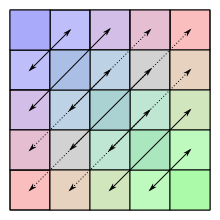
In linear algebra, a symmetric matrix is a square matrix that is equal to its transpose. Formally,
Because equal matrices have equal dimensions, only square matrices can be symmetric.
The entries of a symmetric matrix are symmetric with respect to the main diagonal. So if denotes the entry in the th row and th column then
for all indices and
Every square diagonal matrix is symmetric, since all off-diagonal elements are zero. Similarly in characteristic different from 2, each diagonal element of a skew-symmetric matrix must be zero, since each is its own negative.
In linear algebra, a real symmetric matrix represents a self-adjoint operator[1] represented in an orthonormal basis over a real inner product space. The corresponding object for a complex inner product space is a Hermitian matrix with complex-valued entries, which is equal to its conjugate transpose. Therefore, in linear algebra over the complex numbers, it is often assumed that a symmetric matrix refers to one which has real-valued entries. Symmetric matrices appear naturally in a variety of applications, and typical numerical linear algebra software makes special accommodations for them.
- ^ Jesús Rojo García (1986). Álgebra lineal (in Spanish) (2nd ed.). Editorial AC. ISBN 84-7288-120-2.





